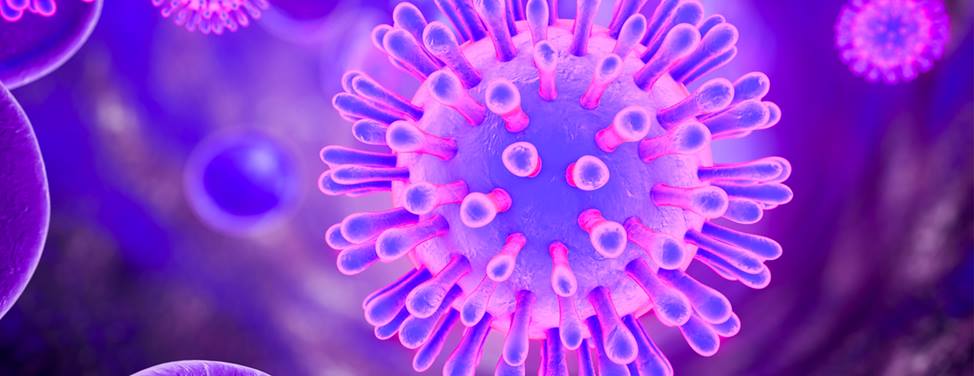AIDS

Overview
AIDS is the advanced stage of HIV infection, when the immune system is damaged. Without treatment, about half of those with HIV develop AIDS within 10 years, although the period between infection and development varies widely, from one to 20 years.
Our approach to AIDS
UCSF has been a pioneer in HIV and AIDS care ever since our HIV/AIDS program welcomed its first patients in 1984. Our comprehensive treatment center is a safe space where patients living with HIV or AIDS can meet their health needs in a single location. We offer a full range of high-quality services, including primary care, sexual health testing and treatment, and provision of preventive tools, such as pre-exposure prophylaxis (PrEP) medication. For individual patients, we tailor care plans that encompass nutrition, medication management, pain management, exercise, mental health, social support and long-term wellness.
We also offer specialty services not widely available, including programs designed to address the particular needs of women and children, older adults and African American men. Our center's telemedicine program helps us reach patients in marginalized or underserved communities, as well as others who face financial, social, time or additional barriers to accessing excellent care.
Finally, as a leader in HIV/AIDS research, UCSF offers patients access to cutting-edge therapies under evaluation in clinical trials.
Signs & symptoms
Symptoms of AIDS are caused by the deterioration of the immune system and the decline of CD4+ T cells, which are the immune system's key infection fighters. As soon as HIV enters the body, it begins to destroy these cells. Some common symptoms include:
- Diarrhea that lasts for more than a week
- Dry cough
- Memory loss, depression and neurological disorders
- Pneumonia
- Profound, unexplained fatigue
- Rapid weight loss
- Recurring fever or profuse night sweats
- Red, brown, pink or purplish blotches on or under the skin or inside the mouth, nose or eyelids
- Swollen lymph glands in the armpits, groin or neck
- White spots or unusual blemishes on the tongue, in the mouth, or in the throat
Infections associated with AIDS
Because people with AIDS have weakened immune systems, they're more prone to infections, called opportunistic infections. Opportunistic infections are caused by organisms that typically don't cause disease in healthy people but affect people with damaged immune systems. These organisms attack when there's an opportunity to infect.
Deterioration of the immune system is caused by the decline in CD4+ T cells, which are key infection fighters. As soon as HIV enters the body, it begins to destroy these cells.
Symptoms of opportunistic infections common with AIDS include:
- Coma
- Coughing and shortness of breath
- Difficult or painful swallowing
- Extreme fatigue
- Fever
- Mental symptoms such as confusion and forgetfulness
- Nausea, abdominal cramps and vomiting
- Seizures and lack of coordination
- Severe, persistent diarrhea
- Severe headaches
- Vision loss
- Weight loss
Many opportunistic infections associated with AIDS cause serious illness. Some may be prevented.
Opportunistic infections
Below is a list of infections and how they affect different parts of the body.
Brain
Cryptoccoccal menigitis – This is a yeast-like fungus infection that usually involves the brain and lungs, although it can affect almost any organ. The fungus that causes this condition is found in soil throughout the world. It is most common in soil contaminated by bird droppings. This disease most often occurs when a person's CD4+ T cell count falls below 100 cells per cubic millimeter of blood.
HIV-related encephalopathy – Encephalopathy is a term for diseases that alter brain function or structure, leading to problems with cognitive function, or mental processes, and memory. In people with HIV and AIDS, encephalopathy is usually caused by an infectious agent, such as a bacteria, virus or prion.
Encephalopathy most often occurs when a person's CD4+T cell count falls below 50 cells per cubic millimeter of blood. Toxoplasma-seropositive patients who have a CD4+T cell count of less than 100 cells per cubic millimeter of blood should be treated with prophylaxis to prevent developing encephalopathy.
Progressive multifocal leukoencephalopathy (PML) – Progressive multifocal leukoencephalopathy is a rare disorder of the nervous system caused by a common human polyomavirus, JC virus. It leads to the destruction of the myelin sheath that covers nerve cells. The myelin sheath is the fatty covering that acts as an insulator on nerve fibers in the brain. Symptoms include mental deterioration, vision loss, speech disturbances, inability to coordinate movements, paralysis and ultimately coma. In rare cases, seizures may occur.
This disease can occur when the CD4+T cell count falls below 200 cells per cubic millimeter of blood.
Toxoplasmosis – This condition occurs when a parasite infects the brain. Symptoms include confusion or delusional behavior, severe headaches, fever, seizures and coma. It can affect the eye, causing eye pain and reduced vision.
Toxoplasmosis most likely occurs when the CD4+ T cell count falls below 100 cells per cubic millimeter of blood. Preventative treatment – usually with trimethoprim-sulfamethoxazole, also called Septra and Bactrim – may be administered when the CD4+ T cell count falls below 100 cells per cubic millimeter of blood.
Eyes
Cytomegalovirus (CMV) – Although this virus can affect the entire body, it commonly affects the eye's retina, causing blurry vision and in severe cases, blindness. Other common symptoms include chronic diarrhea and nerve problems. It is most likely to occur when a person’s CD4+ T cell count falls below 100 cells per cubic millimeter of blood.
Gastrointestinal tract
Cryptosporidiosis – This is a parasite that can cause chronic diarrhea. Other symptoms include stomach cramps, nausea, fatigue, weight loss, appetite loss, vomiting and dehydration.
This infection is difficult to treat and there is no definitive effective treatment. Symptom control and treatment of HIV are necessary.
Cytomegalovirus – Although this virus can affect the entire body, it commonly occurs in the stomach, causing fever, diarrhea and stomach pain. It most likely occurs when the CD4+ T cell count falls below 50 cells per cubic millimeter of blood.
Mycobacterium Avium Complex – This is a bacterial infection that can cause persistent fever, night sweats, fatigue, weight loss, anemia, abdominal pain, dizziness, diarrhea and weakness. The bacteria that cause this infection is found in water, dust, soil and bird droppings.
This disease most likely occurs when the CD4+T cell count falls below 50 cells per cubic millimeter of blood. Preventive treatment, usually with azithromycin, is administered when CD4+ T cells are less than 50 cells per cubic millimeter of blood.
Genitals
Candidiasis – Candidiasis is an infection caused by the candida fungi. Also known as a yeast infection, it's the most common HIV-related fungus infection. It can affect the entire body, but most commonly occurs in the mouth, called thrush, or vagina. An overgrowth of yeast in the vagina can cause irritation, itching, burning and thick white discharge.
Herpes simplex – This virus causes genital herpes, which are painful blisters in the genital area, or cold sores. Severe conditions are more common in the advanced stage of AIDS.
Human papilloma virus (HPV) – This condition is considered the most common sexually transmitted disease (STD) in the United States. It can cause warts on the anus, cervix, esophagus, penis, urethra, vagina and vulva. Studies have shown that certain types of HPV can contribute to the development of cervical and anal cancer. Individuals with HIV and AIDS are at increased risk for developing precancerous and cancerous lesions.
Liver
Liver disease – Liver disease is one of the leading causes of death among AIDS patients, especially liver disease caused by the hepatitis B and hepatitis C virus. Many drugs used in the treatment of HIV and AIDS can cause liver disease or hepatitis. It is important that patients infected with hepatitis receive treatment and follow-up care.
Lungs
Coccidiomycosis – This infection is caused by inhaling an infective fungus called Coccidioides immitis, found mainly in contaminated soil in the southwestern United States, Mexico, Central America and parts of South America. The lungs are most commonly affected by this infection. In severe cases, it can involve the kidneys, lymph system, brain and spleen. Symptoms include cough, weight loss and fatigue. Meningitis is a common complication when left untreated.
Histoplasmosis – This infection almost always involves the lungs, although other organs may be affected. The fungus that causes this condition is found in southern parts of the United States and South America. It is usually found in soil contaminated with bird droppings and must be inhaled to cause infection.
Signs and symptoms include high fever; weight loss; respiratory complaints; an enlarged liver, spleen, or lymph nodes; depressed production of white cells, red blood cells and platelets from the bone marrow; and life-threatening, unstable, low blood pressure.
Pneumocystis carinii – This condition occurs when a fungus infects the lungs. Symptoms may include fever, cough, difficulty breathing, weight loss, night sweats and fatigue.
It is most likely to occur when the CD4+ T cell count falls below 200 cells per cubic millimeter of blood. Preventative treatment may be administered when the CD4+ T cell count falls below 200 cells per cubic millimeter of blood. Treatment is usually trimethoprim-sulfamethoxazole, also called Septra or Bactrim, dapsone or atovoquone.
Recurrent pneumonia – People with AIDS are at risk for recurrent bacterial pneumonia. Bacteria can infect the lungs, which may lead to problems ranging from a mild cough to severe pneumonia. Recurrent pneumonia is most likely to occur when the CD4+ T cell count falls below 200 cells per cubic millimeter of blood.
Tuberculosis (TB) – This is a serious, and often deadly, bacterial infection that primarily infects the lungs. TB is transmitted when a person with active TB coughs or sneezes, releasing microscopic particles into the air. If inhaled, these particles may transmit the condition.
Once infected by TB, most people remain healthy and develop only latent infection. People with latent infection are neither sick nor infectious. However, they do have the potential to become sick and infectious with active TB. It can occur at any CD4+ T cell level but especially when the CD4+ T cell count falls below 350 cells per cubic millimeter of blood.
Lymphatic system
Non-Hodgkin's lymphoma – Non-Hodgkin's lymphoma is a disease in which tumors develop from white blood cells in the lymphatic system. It is another common disease associated with AIDS. See AIDS-related lymphoma.
Mouth and throat
Candidiasis – This is the most common HIV-related fungus infection. It can affect the entire body, but most commonly occurs in the mouth (thrush) or vagina. An overgrowth of yeast causes white patches on gums, tongue or lining of the mouth, pain, difficulty in swallowing and loss of appetite. Candida in the esophagus, trachea, bronchi or lungs is AIDS defining.
Skin
Herpes simplex – This virus causes cold sores or genital herpes, which are painful blisters in the genital area. Chronic herpes simplex virus (HSV) lesions and severe mucocutaneous HSV disease are common in the advanced stages of AIDS.
Kaposi's sarcoma – This is the most common AIDS-related cancer. It causes reddish-purple lesions that usually appear on the skin. They also can appear on the lymph nodes, mouth, gastrointestinal tract and lungs.
Shingles – Shingles are caused by a reactivation of the chicken pox virus. It may cause a painful rash or blisters that follow the path of nerves.
Diagnosis
People are diagnosed with AIDS when they have certain signs or symptoms defined by the U.S. Centers for Disease Control and Prevention (CDC). The CDC's definition of AIDS includes:
- Less than 200 CD4+ T cells per cubic millimeter of blood, compared with about 1,000 CD4+ T cells for healthy people. CD4+T cells are white blood cells that play an important role in the body's immune system. These cells are destroyed by HIV. Even when a HIV-positive person feels well and is not experiencing any symptoms of the disease, CD4+ T cells are being infected by HIV.
- CD4+ T cells accounting for less than 14 percent of all lymphocytes, a type of white blood cell.
One of more of the illnesses listed below:
- Candidiasis of bronchi, esophagus, trachea or lungs
- Cervical cancer that is invasive
- Coccidioidomycosis that has spread
- Cryptococcosis that is affecting the body outside the lungs
- Cryptosporidiosis affecting the intestines and lasting more than a month
- Cytomegalovirus disease outside of the liver, spleen or lymph nodes
- Cytomegalovirus retinitis that occurs with vision loss
- Encephalopathy that is HIV-related
- Herpes simplex including ulcers lasting more than a month or bronchitis, pneumonitis or esophagitis
- Histoplasmosis that has spread
- Isosporiasis affecting the intestines and lasting more than a month
- Kaposi's sarcoma
- Lymphoma that is Burkitt type, immunoblastic or that is primary and affects the brain or central nervous system
- Mycobacterium avium complex or disease caused by M kansasii
- Mycobacterium tuberculosis in or outside the lungs
- Other species of mycobacterium that has spread
- Pneumocystis jiroveci, formerly called carinii, pneumonia
- Pneumonia that is recurrent
- Progressive multifocal leukoencephalopathy
- Salmonella septicemia that is recurrent
- Toxoplasmosis of the brain, also called encephalitis
- Wasting syndrome caused by HIV infection
Symptoms also may include anxiety, dementia, depression and insomnia.
Blood tests are the most common way to diagnose the human immunodeficiency virus (HIV), the virus that causes acquired immunodeficiency syndrome (AIDS). These tests look for antibodies to the virus that are present in the blood of infected individuals. People exposed to the virus should get tested immediately.
Early testing is crucial with HIV. If you test positive for the virus, you and your doctor can develop a treatment plan to help fight HIV and ward off complications. Early testing also can alert you to avoid high-risk behavior that could spread the virus to others.
Because it can take from six weeks to six months to develop antibodies to the virus, follow-up tests may be needed. Your doctor will ask about your symptoms, medical history and risk factors and perform a physical examination.
The primary tests for diagnosing HIV and AIDs include:
- ELISA test. ELISA, which stands for enzyme-linked immunosorbent assay, is used to detect HIV infection. If an ELISA test is positive, the Western blot test is usually administered to confirm the diagnosis. If an ELISA test is negative, but you think you may have HIV, you should be tested again in one to three months. ELISA is quite sensitive in chronic HIV infection, but because antibodies aren't produced immediately upon infection, you may test negative during a window of a few weeks to a few months after being infected. Even though your test result may be negative during this window, you may have a high level of the virus and be at risk of transmitting infection.
- Home tests. The only home test approved by the U.S. Food and Drug Administration is called the Home Access Express Test, which is sold in pharmacies.
- Saliva tests. A cotton pad is used to obtain saliva from the inside of your cheek. The pad is placed in a vial and submitted to a laboratory for testing. Results are available in three days. Positive results should be confirmed with a blood test.
- Viral load test. This test measures the amount of HIV in your blood. Generally, it's used to monitor treatment progress or detect early HIV infection. Three technologies measure HIV viral load in the blood — reverse transcription polymerase chain reaction (RT-PCR), branched DNA (bDNA) and nucleic acid sequence-based amplification assay (NASBA). The basic principles of these tests are similar. HIV is detected using DNA sequences that bind specifically to those in the virus. It is important to note that results may vary between tests.
- Western blot. This is a very sensitive blood test used to confirm a positive ELISA test result.
Treatments
At this time, there is no cure for AIDS, but medications are effective in fighting HIV and its complications. Treatments are designed to reduce HIV in your body, keep your immune system as healthy as possible and decrease the complications you may develop.
You and your doctor will work together to develop a treatment plan that best meets your needs. Three main factors will be considered when designing your treatment plan:
- Your willingness and readiness to begin therapy
- The stage of your disease
- Other health problems
The U.S. Food and Drug Administration (FDA) has approved a number of drugs for treating HIV and AIDS. It's important that you take your medications exactly as prescribed. This is a crucial part of your treatment success. Our program offers pharmacy services to help you maintain your drug regimen and to answer any questions you may have.
Most medications have side effects, which your doctor will discuss with you. Individuals respond differently to medications and side effects may vary. Our doctors, nurses and pharmacists can help you manage these side effects.
AIDS medications
Although there is no cure for acquired immunodeficiency syndrome (AIDS), medications have been highly effective in fighting HIV and its complications. Drug treatments help reduce the HIV virus in your body, keep your immune system as healthy as possible and decrease the complications you may develop.
Some of the drugs approved by the FDA for treating HIV and AIDS are listed below.
Nucleoside reverse transcriptase inhibitors (NRTI)
These drugs interrupt the virus from duplicating, which may slow the spread of HIV in the body. They include:
- Abacavir (Ziagen, ABC)
- Didanosine (Videx, dideoxyinosine, ddI)
- Emtricitabine (Emtriva, FTC)
- Lamivudine (Epivir, 3TC)
- Stavudine (Zerit, d4T)
- Tenofovir (Viread, TDF)
- Zalcitabine (Hivid, ddC)
- Zidovudine (Retrovir, ZDV or AZT)
Combinations of NRTIs make it possible to take lower doses and maintain effectiveness. These drugs include Combivir (Zidovudine and Lamivudine), Trizivir (Zidovudine, Lamivudine and Abacavir), Epzicom (Abacavir and Lamivudine) and Truvada (Tenofovir and Lamivudine). We expect more combination drugs to be available in the future.
Side effects of NRTIs
Side effects from taking NRTIs vary, depending on the individual. We recommend that you consult with your doctor regarding any side effects you experience. Common side effects include:
- Abacavir (Ziagen, ABC). Side effects may include fever, rash, fatigue, vomiting, diarrhea, abdominal pain, malaise or fatigue, loss of appetite and respiratory symptoms.
- Dideoxyinosine (Videx, ddI). Side effects may include nausea, vomiting and bloating. More serious side effects include pancreatitis and peripheral neuropathy. Peripheral neuropathy is a common neurological disorder resulting from damage to the peripheral nerves. Symptoms of peripheral neuropathy include a sharp, burning pain sensation in the hands or legs.
- Lamivudine (Epivir, 3TC). Side effects may include cough, diarrhea, dizziness, headache, loss of appetite, mild stomach cramps or pain and trouble sleeping. More serious side effects include burning, tingling, or pain in the hands, arms, feet, or legs; chills; ear, nose, or throat problems; fever; muscle aches; nausea; pale skin; severe stomach pain; skin rash; unusual tiredness or weakness; vomiting; and yellow eyes or skin.
- Stavudine (Zerit, d4T). Side effects may include peripheral neuropathy. Symptoms of peripheral neuropathy include a sharp, burning pain sensation in the hands or legs. In rare cases, Stavudine also may cause pancreatitis.
- Tenofovir (Viread, TDF). Side effects may include weakness and lack of energy, headache, diarrhea, nausea, vomiting and intestinal gas. More serious side effects include liver or kidney failure and pancreas disease.
- Zalcitabine (Hivid, ddC). Side effects may include oral ulcers and peripheral neuropathy. Symptoms of peripheral neuropathy include a sharp, burning pain sensation in the hands or legs.
- Zidovudine (Retrovir, ZDV or AZT). Side effects may include diarrhea, nausea, vomiting, headache, insomnia, weakness and fatigue, bone marrow suppression, anemia and neutropenia. Neutropenia refers to an abnormally low number of neutrophils in the blood. Neutrophils, a type of white blood cell, help fight bacterial infections. Neutropenia isn't a disease but a sign of an underlying problem. In mild cases, it may cause no symptoms. Severe neutropenia increases the risk of infection of the lungs, kidneys, blood and skin.
Protease inhibitors (PI)
These FDA-approved drugs interrupt virus replication at a later step in the virus life cycle. Protease inhibitors include:
- Amprenavir (Agenerase, APV)
- Atazanavir (Reyataz, ATV)
- Fosamprenavir (Lexiva, FOS)
- Indinavir (Crixivan, IDV)
- Lopinavir (Kaletra, LPV/r)
- Ritonavir (Norvir, RIT)
- Saquinavir (Fortovase, Invirase, SQV)
Side effects of PIs
Side effects from protease inhibitors vary, depending on the individual. We recommend that you consult with your doctor to discuss any side effects you may experience. The following is a list protease inhibitors and their possible side effects:
- Amprenavir (Agenerase, APV). Side effects include nausea, diarrhea, vomiting, rash, numbness around the mouth and abdominal pain. About 1 percent of people have serious skin reactions, including Stevens-Johnson syndrome.
- Atazanavir (Reyataz, ATV). Side effects include headache, rash, stomach pain, vomiting, depression, increased cough, trouble sleeping, tiredness, back pain, joint pain, as well as numbness, tingling or burning of the hands or feet. More serious side effects include yellowing of the eyes or skin, change in heart rhythm, diabetes and high blood sugar, diarrhea, infection, nausea and blood in the urine.
- Fosamprenavir (Lexiva, FOS). Side effects may include rash, nausea and diarrhea.
- Indinavir (Crixivan, IDV). Side effects include change in sense of taste, diarrhea, nausea, vomiting, dizziness or drowsiness, general feeling of weakness, headache, stomach pain and trouble sleeping. More serious side effects include kidney stones, changes in body fat, increased bleeding in patients with hemophilia, high sugar and fat levels in the blood, and onset or worsening of diabetes.
- Lopinavir (Kaletra, LPV/r). Side effects include abdominal pain, abnormal stools or bowl movements, diarrhea, feeling weak or tired, headache and nausea. In addition, patients taking Lopinavir should be monitored for possible liver problems. People taking the drug who have liver disease, such as hepatitis B or hepatitis C, may experience a worsening of their liver condition. A small number of patients have experienced severe liver problems.
- Nelfinavir (Viracept, NFV). Side effects include diarrhea, weakness, headache, nausea and abdominal pain.
- Ritonavir (Norvir, RIT). Ritonavir often is used in combination with other protease inhibitors — an approach called "Ritonavir boosting." Studies have shown that small amounts of Ritonavir, taken in combination with other PIs, can boost or increase the strength and effectiveness of some drugs and may overcome drug and food interactions. In some cases, "Ritonavir boosting" reduces the number of pills necessary or how often they're taken. The disadvantage is that Ritonavir interacts with many drugs, both prescription and over the counter. It is important that you speak with your doctor about all your medications before taking Ritonavir. Side effects include general weakness, burning or prickling sensation in the hands and feet, stomach pain, diarrhea, constipation, indigestion, flatulence, nausea, vomiting, loss of appetite, change in sense of taste, headache, dizziness, drowsiness, insomnia, fever, throat irritation, abnormal thinking, rash, sore throat and sweating. More serious effects include pancreas disease, changes in body fat, increased bleeding in patients with hemophilia, high sugar and fat levels in the blood, and onset or worsening of diabetes.
- Saquinavir (Fortovase, Invirase, SQV). Side effects are related to the stomach and intestinal system, including diarrhea, nausea, stomach-intestinal pain, heartburn, rectal gas, vomiting, altered taste sensation, headache, fatigue, depression, sleep disturbance including insomnia, anxiety, sex drive disorder, muscle aches, rash, hepatitis and abnormal fat redistribution.
Other AIDS medications
Fusion inhibitors
Fusion inhibitors are a new class of drugs that act against HIV by preventing the virus from fusing with the inside of a cell, preventing it from replicating. The group of drugs includes Enfuvirtide, also known as Fuzeon or T-20.
Highly active antiretroviral therapy (HAART)
In 1996, highly active antiretroviral therapy (HAART) was introduced for people with HIV and AIDS. HAART — often referred to as the anti-HIV "cocktail" — is a combination of three or more drugs, such as protease inhibitors and other anti-retroviral medications. The treatment is highly effective in slowing the rate at which the HIV virus replicates itself, which may slow the spread of HIV in the body. The goal of HAART is to reduce the amount of virus in your body, or the viral load, to a level that can no longer be detected with blood tests.
Non-nucleoside reverse transcriptase inhibitors (NNRTI)
Non-nucleoside reverse transcriptase inhibitors (NNRTIs) block the infection of new cells by HIV. These drugs may be prescribed in combination with other anti-retroviral drugs. NNRTs include:
- Delvaridine (Rescriptor, DLV)
- Efravirenz (Sustiva, EFV)
- Nevirapine (Viramune, NVP)
UCSF Health medical specialists have reviewed this information. It is for educational purposes only and is not intended to replace the advice of your doctor or other health care provider. We encourage you to discuss any questions or concerns you may have with your provider.















